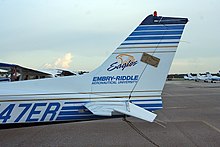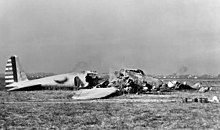Gust lock
This articleneeds additional citations forverification.(July 2022) |

Agust lockon anaircraftis a mechanism that lockscontrol surfacesand keeps open aircraft doors in place while the aircraft is parked on the ground and non-operational. Gust locks prevent wind from causing unexpected movements of the control surfaces and their linked controls inside the aircraft, as well as aircraft doors on some aircraft; otherwise, wind gusts could cause possible damage to the control surfaces and systems, or to nearby people, cargo, or machinery. Some gust locks are external devices attached directly to the aircraft's control surfaces, while others are attached to the relevant flight controls inside the cockpit.
Safety
[edit]A gust lock can pose a serious safety hazard if it is not disengaged before an aircraft's takeoff, because it renders the flight control inoperative. Many internal gust locks have a safety feature that locks out the aircraft's throttle or engine-start controls until removed and stowed. External-only gust locks typically lack this safety feature, and must be tagged with a large redremove before flightstreamer.

The firstBoeing B-17 Flying Fortressever built, the initial Model 299 aircraft, was lost in just this way on October 30, 1935, when its gust locks were left engaged, with the resulting crash killing Boeing chief test pilot Leslie Tower andUnited States Army Air Corpstest pilotPloyer Peter Hill.[1]Less than a year later, German LuftwaffeGeneralleutnantWalter Weverlost his life in a similar accident from gust lock neglect, when hisHeinkel He 70Blitzmonoplane crashed on June 3, 1936, from theBlitz'saileron gust locks not being disengaged before takeoff.[citation needed]Prince Gustaf Adolf of Sweden,the American singer and actressGrace Mooreand 20 others were killed in 1947 during the crash of aKLM flightat Copenhagen Airport due to the flight crew forgetting to disengage the gust lock on the elevators of the aircraft. In 1977 the crash ofAir Indiana Flight 216occurred due to failure to remove the gust locks.
A C-124 transport carrying US servicemen home for Christmascrashed in 1952due to engagement of gust locks.
Dan-Air Flight 0034,a Hawker Siddeley 748 series 1 (registration G-BEKF) operating an oil industry support flight crashed on July 31, 1979 atSumburgh Airportin the Shetland Islands. The aircraft failed to become airborne, ran through the perimeter fence, and crashed into the sea. The accident was due to the elevator gust lock having become re-engaged, preventing the aircraft from rotating into a flying attitude. The aircraft was destroyed and 17 of the 47 people on board drowned.
On August 27, 1992, atGimli Industrial Park Airport,a modified version of theDHC-4 Cariboucrashed due to a design flaw which permitted the gust-locks to engage during take-off.[2][3]
On May 31, 2014, a gust lock left in place caused thecrashof aGulfstream IVatHanscom Field,killingPhiladelphia Inquirerco-ownerLewis Katzas well as six others.[4]
On July 24, 2021, in Lewiston, Idaho, former Naval Aviator and F-14 Tomcat pilotDale Snodgrasswas killed when the plane he was piloting crashed due to loss of control on takeoff caused by the gust lock not being removed before the flight.[5]
See also
[edit]- Remove before flight
- Lists of aviation topics
- List of aviation, avionics, aerospace and aeronautical abbreviations
References
[edit]- ^Doyle, David (2020).B-17 Flying Fortress, Vol. 1: Boeing's Model 299 through B-17D in World War II.Atglen: Schiffer Publishing, Ltd. pp. 6–7.ISBN9780764359552.
- ^"ASN Aircraft accident de Havilland Canada DHC-4T Caribou N400NC Gimli Airport, MB (YGM)".
- ^"Tech Support Forum".
- ^"NTSB: Pilots left wing controls locked in place in Gulfstream crash that killed 7".USA Today.
- ^"CAROL Query: investigations July 2021".Data.ntsb.gov.Retrieved2022-08-19.[not specific enough to verify]
"Gust lock".The Illustrated Encyclopedia of Aviation and Space.Vol. 6. Los Angeles: A.F.E. Press. 1971. p. 1043.LCCN68014013.
External links
[edit] Media related toGust locksat Wikimedia Commons
Media related toGust locksat Wikimedia Commons
